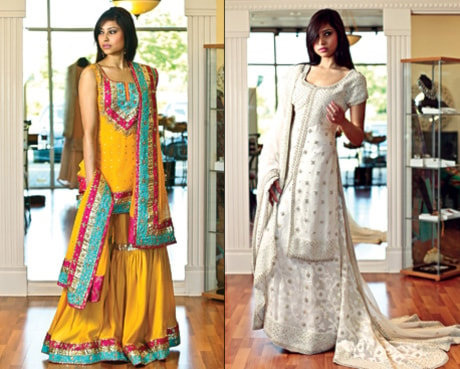She found the guy, got engaged, set the date and booked the multiple venues to accommodate 150 people for her traditional three-day Hindu wedding.
That was the easy part.
Then Garima Jain realized she would need five different outfits to wear for the festivities.
Not to mention an additional nine outfits for her trousseau. In total, Jain expects to receive 31 dresses from family.
“I was so stressed out,” says Jain, whose traditional Hindu wedding in August involves five ceremonies over those three days.
“At first I didn’t even know where to start,” she says. “Where do you go to buy not one, but almost 10 outfits, for an Indian wedding in Toronto?”
Welcome to the world of South Asian weddings, where multi-day ceremonies are the rule, not the exception.
And what the bride wears for every occasion is the most important decision of all.
“The bride is the centre of attention. All eyes are on her,” says Dimple Madan, who runs the boutique Tanzeb, which specializes in the latest styles from India.
Jain managed to get all her wedding outfits, plus most of her 22 outfits for her trousseau — a tradition where the bride receives suits from her family and in-laws — from Madan.
Options for bridal wear in the city have boomed — thanks to a growing South Asian population in Toronto and the surrounding area.
Brides who once made the trip to the homeland for their wedding needs can easily find clothes here.
A decade ago, India Bazaar on Gerrard Street was the only hope for brides, but now smaller boutiques in Mississauga and Brampton have started to fill the void.
Most boutiques make custom outfits for brides, ranging in price from $1,000 to $6,000, depending on the design and intricacy of work on the outfit, says Madan.
Gul Saleem, who helps her mom Zakia Khan run Jamayz, a bridal boutique in Mississauga, says a recent high-end outfit was a $5,000 bridal sari.
“We used the best satin, it was handmade Italian lace that was appliqued on to the sari in certain areas.
“The border on the bottom was eight inches (20 centimetres), full of stones, pearls and diamonds all hand-done,” says Saleem, who has also opened a more casual clothing line called Sherbano.
“We had 10 men working on that sari over the course of two weeks. It was absolutely stunning — a show stopper.”
South Asian weddings are week-long affairs, bustling with numerous pre-wedding parties, wedding functions and post-wedding formalities.
The first official event is the festive henna party, where henna is applied to the bride’s hands and feet, and friends sing songs to usher in the joyous occasion.
The next event is usually the official marriage ceremony, and a reception ends the week of festivities.
In the past, each event would be associated with a different colour outfit.
Many brides opted to wear yellow on the first day, red for the wedding day and a colour of their liking for the reception.
Today, South Asian brides have the pick of any colour on the palette, the choice of dozens of different materials, bead work, embroidery and a range of style options: there is the ankle-length skirt-like lengha, sari, the culottes-like gararah, the simpler shalwar kameez or the dress-like peshwaas.
The options are enough to turn any bride into bridezilla.
“I feel like we’re counselling them and guiding them when they come in to get their outfits,” says Saleem.
“It can really be overwhelming for some.”
Jain was looking for the latest Indian designs in the skirt-like lenghas when she started her dress search. She opted for traditional reds and maroon and delicate embroidery work on the skirt.
Sara Alvi, a bride who is getting married in July in a traditional Muslim wedding, chose non-traditional pink for her wedding, and green for the henna day.
While she bought some outfits in Toronto, she opted to get her wedding dress from Pakistan, where bridal fashion changes every year.
“The main thing for me is that Indian bridal fashion might change in colour, but the style is usually lengha, with a short choli shirt,” she says.
“For us, the type of pants and skirts you might wear changes. Also, we have a lot more colour options. Indians tend to wear red for the ceremony. We can wear any colour, and our embroidery changes, too,” she says.
Trend trumps tradition when it comes to fashion for Pakistani brides, says Khan, who has been in the bridal clothes business for nearly a decade.
“Stone work, diamonds, pearl work and semi-precious stones are really in right now,” says Khan.
“We are also seeing a big trend in long shirts instead of short over the lengha, or a gararah,” she says. “In terms of colour, green and pink are very popular right now.”
Some brides raised in Canada have a different idea of what they want for their wedding than what fashion dictates in their mother country.
“They want to find a way to bridge the gap between back home and Canadian style,” says Mona Khan, who runs Mehnaz boutique in Maple, northwest of Toronto.
“We see a lot of brides asking for off-white and two-piece outfits that look like a traditional white wedding dress,” she says.
Now that the outfits have been taken care of, Jain admits that getting new clothes is one of the best things about getting married.
“Yes, there is some stress, but to be honest, it’s a lot of fun. Which girl doesn’t like getting a whole new wardrobe?”
